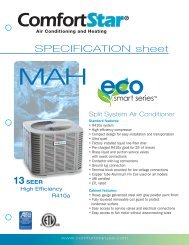Installation &Operation Instructions For R410A (MAH ... - ComfortStar
Installation &Operation Instructions For R410A (MAH ... - ComfortStar
Installation &Operation Instructions For R410A (MAH ... - ComfortStar
Create successful ePaper yourself
Turn your PDF publications into a flip-book with our unique Google optimized e-Paper software.
CAUTION<br />
Dry nitrogen should always be supplied through the tubing while it is being<br />
brazed, because the temperature required is high enough to cause oxidation<br />
of the copper unless an inert atmosphere is provide. The flow of dry nitrogen<br />
should continue until the joint has cooled. Always use a pressure regulator<br />
and safety valve to insure that only low pressure dry nitrogen is introduced into<br />
the tubing.Only a small flow is necessary to displace air and prevent oxidation.<br />
3.7 PRECAUTIONS DURING BRAZING SERVICE VALVE<br />
Precautions should be taken to prevent heat damage to service valve by wrapping a wet<br />
rag around it as shown in Fig. 6. Also, protect all painted surfaces, insulation, during<br />
brazing. After brazing cool joint with wet rag.<br />
Valve can be opened by removing the plunger cap and fully inserting a hex wrench into<br />
the stem and backing out counter-clockwise until valve stem just touches the chamfered<br />
retaining wall.<br />
Connect the refrigerant lines using the following procedure:<br />
1. Remove the cap and Schrader core from both the liquid and vapor service valve<br />
service ports at the outdoor unit. Connect Iow pressure nitrogen to the liquid line<br />
service port.<br />
wet rag<br />
service valve<br />
Fig.6 Heat Protection<br />
2. Braze the liquid line to the liquid valve at the outdoor unit. Be sure to wrap the valve<br />
body with a wet rag. Allow the nitrogen to continue flowing. Refer to the Tabular Data<br />
Sheet for proper liquid line sizing.<br />
3. Carefully remove the rubber plugs from the evaporator liquid and vapor connections<br />
at the indoor coil.<br />
4. Braze the liquid line to the evaporator liquid connection. Nitrogen should be flowing<br />
through the evaporator coil.<br />
5. Slide the plastie cap away from the vapor connection at the indoor coil. Braze the<br />
vapor line to the evaporator vapor connection. Refer to the Table 1 for proper vapor<br />
line sizing.<br />
6. Protect the vapor valve with a wet rag and braze the vapor line connection to the<br />
outdoor unit. The nitrogen flow should be exiting the system from the vapor service<br />
port connection. After this connection has cooled, remove the nitrogen source from<br />
the liquid fitting service port.<br />
7. Replace the Schrader core in the liquid and vapor valves.<br />
8. Leak test all refrigerant piping connections including the service port flare caps to be<br />
sure they are leak tight. DO NOT OVER TIGHTEN (between 40 and 60 inch -lbs.<br />
maximum).<br />
9. Evacuate the vapor line, evaporator and the liquid line, to 500 microns or less.<br />
9




